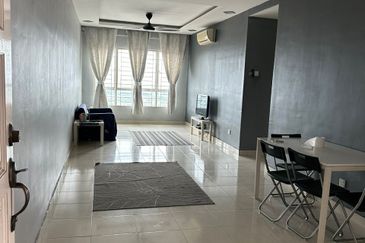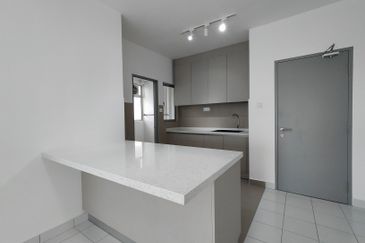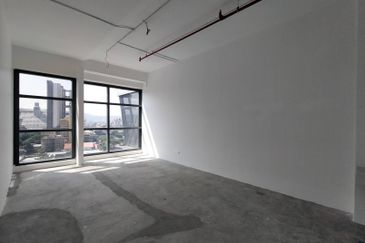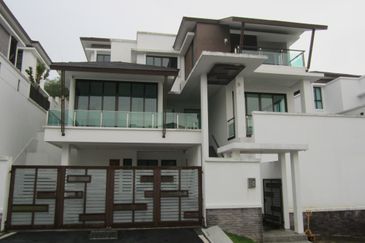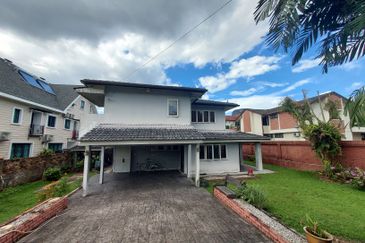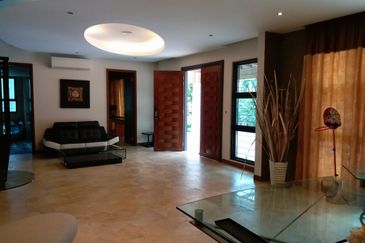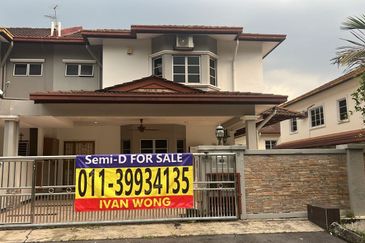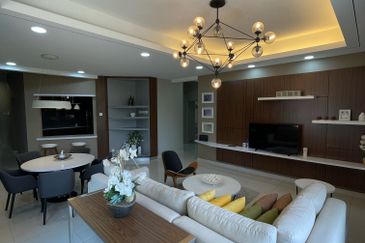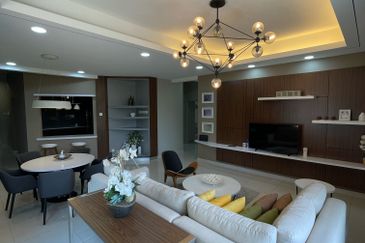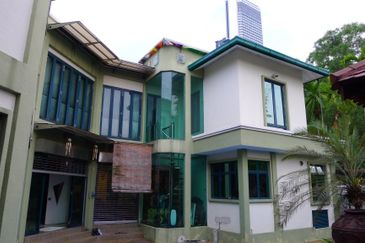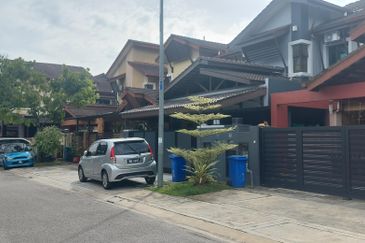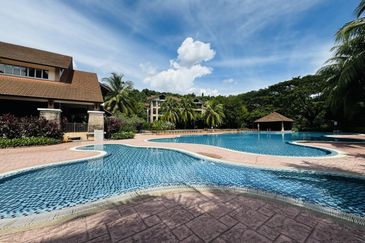A sad story of subpar developments, oversupply and lack of demand
What can you buy with RM6,480?
If you’re a techie, you could go out and buy up to four Apple iPads — currently tagged at US$499 (about RM1,600) at the Apple online store. Add another RM300 and you could take home a 2.13 Ghz MacBook Air with Intel Core 2 Duo processor, 2GB memory and a host of other specifications. That would cost you RM6,799 or thereabouts.
For women into fashion, RM6,000-odd is but a fraction of the price of a Burberry Alligator barbed wire chain tote bag. The Burberry online store has priced this at a cool £12,250 (RM58,566).
Or, you could step on the first rung of the property ladder. In fact, RM6,480 was all someone paid for a 650 sq ft low-cost flat in Taman Bunga Raya in Bukit Beruntung, Selangor. The unit was among the 139 distressed flats and apartments in Bukit Beruntung put up in a joint auction by five auctioneers in Kuala Lumpur on April 23. Four days earlier, on April 19, another 67 similar units in Bukit Beruntung also went under the hammer.
The April 23 auction attracted a turnout of about 100, most of them interested in properties located outside Bukit Beruntung. Properties in Cheras, Ampang, Kepong and Shah Alam saw keen bidding, unlike those in Bukit Beruntung that attracted little or no interest.
 Most of the auctioned flats in Bukit Beruntung are located in Taman Bunga Raya, a township developed by MK Land Holdings Bhd. Owners had paid between RM25,000 and RM42,000 for these in the 1990s, but they are now being auctioned off for between RM6,000 and about RM15,000 each.
Most of the auctioned flats in Bukit Beruntung are located in Taman Bunga Raya, a township developed by MK Land Holdings Bhd. Owners had paid between RM25,000 and RM42,000 for these in the 1990s, but they are now being auctioned off for between RM6,000 and about RM15,000 each.
In stark comparison, in the bustling but not exactly exclusive part of the Klang Valley, high-rise homes are priced at around RM400 or more psf. So, RM6,480 will get you a mere 16.2 sq ft (imagine a 4ft by 4ft table) of space.
In the last decade, financial institutions have regularly put under the hammer low and medium-cost apartments and flats in Bukit Beruntung and even Serendah as their owners are either unable or unwilling to service their mortgages.
For those who recall, back during the property boom in the early 1990s, Bukit Beruntung was a property hotspot. Speculators and genuine investors, lured by the prospect of either flipping the investment or riding on prospective good and stable yields, rushed in with the required 10% to 20% downpayment.
Fortunes turned when purported projects, such as an Islamic university and a new airport (the Kuala Lumpur International Airport has since come up in Sepang), failed to materialise. Bukit Beruntung lost its lustre overnight.
An auctioneer tells City & Country that buyers of the apartments and flats at auction are mostly investors. Even though development may be inching towards Bukit Beruntung, he believes it will be a while before the address will be popular, given its location and lack of amenities.
 The auctioneer says new owners sometimes invest further in simple renovations before putting the units up for rent. “They will still make money if they rent it out for RM200 … the tenants are mostly Indonesians. Actually, the government should buy, renovate and relocate squatters to the apartment blocks. It is cheaper than building new ones,” suggests the auctioneer who declines to be named.
The auctioneer says new owners sometimes invest further in simple renovations before putting the units up for rent. “They will still make money if they rent it out for RM200 … the tenants are mostly Indonesians. Actually, the government should buy, renovate and relocate squatters to the apartment blocks. It is cheaper than building new ones,” suggests the auctioneer who declines to be named.
Carey Real Estate (Ampang) director Avtar Singh is familiar with Bukit Beruntung, and he does not expect any major recovery in the area in the next three to five years. Property prices there have been slashed by half since 1997, except for the bungalows and industrial units, he says.
“The area has no new supply of bungalows and industrial and prices have seen a slight improvement from the end of last year. On the other hand, apartments, 1-storey factories, shophouses and office blocks are in abundance and prices have been deteriorating,” he tells City & Country.
On the other hand, apartments, 1-storey factories, shophouses and office blocks are in abundance and prices have been deteriorating,” he tells City & Country.
Avtar Singh does not expect values, especially those of the flats and apartments, to dip further. However, he still does not see the area turning around immediately.
“The problem now is that banks are reluctant to give full loans for properties in Rawang after the Bukit Beruntung lesson,” he says.
Tang Chee Meng, COO of Henry Butcher Asset Auctioneers, says Bukit Beruntung property prices have dropped due to the effects of subpar developments, over-supply and low demand.
“A number of projects have been abandoned and many completed properties are still not occupied after some years. Some of these properties have been vandalised and are now in a dilapidated state, making it even harder to attract people to buy or live here,” he notes.
Nevertheless, the area seems to be seeing a ray of light — thanks to the just concluded by-election in Hulu Selangor. The authorities have pledged to bring life to its surrounding areas with the construction of a university, several schools, an expressway interchange and infrastructure, as well as a RM15.6 million allocation to repair low-cost flats in Bukit Sentosa. Community guilds and associations have received grants, while mosques and temples will be upgraded.
Construction firm Sunshine City Development Sdn Bhd must be convinced of better times in Bukit Beruntung. Last month, it launched, just a stone’s throw away from the North-South highway exit (Bukit Beruntung toll), 229 units of 2-storey retail units on a 14.7-acre freehold tract.
With a standard lot size of 2,600 sq ft, these are tagged from RM218,000 to RM883,000. At press time, some 147 units, or 64%, had been sold. The company acquired the land, together with the development order, from Talam Corp Bhd in 4Q2009.
JS Valuers Property Consultants Sdn Bhd director Chan Wai Seen says major commercial activities by the government are needed to boost Bukit Beruntung.
For example, he says, if the master plan of Proton City in Tanjung Malim is to fully take off it would raise the profile of surrounding areas like Rasa and Bukit Beruntung. The plan includes the development of factories for vendors and suppliers, which has yet to be implemented.
“Proton City is the immediate and ready-to-be development in that area. The area really needs commercial activities and it is dependent on the government … if private developers want to go there, the projects must be very niche. Mines Golf City (by Mines Resort City founder Tan Sri Lee Kim Yew) is one of the best examples,” he says.
In 2008, Lee began the building of a world-class golf course-cum-residential development called Mines Golf City in the vicinity of Bukit Beruntung.
The ambitious project will feature a 63-hole golf course, the country’s largest, along with residential development. Should the developer succeed in obtaining approval to manage the existing 36-hole Bukit Beruntung Golf & Country Club, adjacent to the Mines Golf City site and owned by the Selangor state government, Lee would create a 99-hole golf course, unprecedented in this country.
Mines Golf City, which comes under Mines Golf City Sdn Bhd, is a 70:30 joint venture of Lee’s privately-owned company and Country Heights Holdings Bhd. With a gross development value of RM3 billion, the project spans a 2,100-acre freehold tract formerly known as Rasa Estate. The acquisition of the land was completed in January 2008.
JS Valuers’ Chan says the university, which the government promised to build in Hulu Selangor during the by-election, will boost property values there. While a direct radius of 1km to 2km from the university will be the main development areas, the project will also benefit the surrounding areas.
Still, Chan would not put money in Bukit Beruntung immediately. Investors, he advises, should wait for more developments to emerge before taking the plunge.
Ghost Town
City & Country took the 45-minute drive recently to take a look at Bukit Beruntung, only to be greeted by the sight of abandoned, vandalised high-rise flats and apartments.
Window frames, glass doors and even electricity cables were missing. Few of the units are occupied and the area is generally in dire need of maintenance, with overgrown weeds lining the roads.
Hypermarket operator Tesco bought 25 acres of freehold land in Bukit Beruntung from Talam Corp Bhd in April 2007 for RM18.59 million. On it now is its largest depot in Malaysia.
Talam Corp started the development of Bukit Beruntung, located in the north of the Klang Valley, during the 1990s boom times. The area’s fortunes turned abruptly from both the impact of the Asian economic crisis and the government’s decision to site the Kuala Lumpur International Airport in Sepang, in the south of Selangor, rather than in the north.
Another developer then active in Bukit Beruntung was MK Land Holdings Bhd, which built Taman Bunga Raya which offered low- and medium-cost apartments and flats.
Keon (not his real name) bought not one but two apartment units in Bukit Beruntung in 1995 — all because he was attracted to the developer’s tagline — “The second Petaling Jaya”. He paid RM80,000 for each 800 sq ft apartment, and these were completed and handed over in 1998.
“Back then the advertisements said Bukit Beruntung would be a second PJ because the new airport and Proton City would be coming in Tanjung Malim, which is about 45km or a 38-minute drive away. The state government at that time even came out with a development plan involving Batang Kali, Hulu Selangor and Hulu Yam, but nothing has taken off,” he laments.
While Proton City now sits on a 4,000-acre tract 5km north of Tanjung Malim in Perak, the new airport was built in Sepang. Neither did the university that was supposed to be built in Bukit Beruntung materialise. A college was built there, but it has since closed down.
Keon believes that 80% of the investors in Bukit Beruntung were Petaling Jaya residents, like himself. Many of his former colleagues also invested in the small-medium industrial (SMI) lots there but lived to regret it.
“Some don’t want to service the loan and the bank just auctions them. They bought the units for more than RM200,000 but they are auctioned off for about RM100,000.”
After paying the maintenance fees for his two apartments faithfully for many years, even Keon has given up. “I do not see any maintenance being done and the apartments, both empty, have been broken into. Practically everything — TNB cables, window panes and metal frames — has been stolen.
“Even the glass balcony door has been broken and its lock damaged. I used to check on the units every month, but now I’m so heartsick that I only go there once in a few months. The situation is getting worse and worse. I want to sell them but there are no takers,” he says.
Broken dreams
It is little comfort for Keon to know that he is not alone in his dilemma. Cammi (not her real name) has a more heartbreaking story to share. Her father-in-law bought five properties in Bukit Beruntung in 1992 and 1995, thinking the place would become a vibrant city. His intention was to relocate the family business, and eventually the entire family, to the area.
Instead, the family is now stuck with a 22,800 sq ft bungalow plot, a 43,400 sq ft industrial plot, two units of 1-storey terraced homes and a 1½-storey factory. All these cost the family close to a million ringgit, Cammi tells City & Country.
“The township did not take off and we didn’t move over there. We are trying to rent them out but we can’t get any tenants except for the 1-storey terraced houses (built-up 1,302 sq ft) for which we are getting less than RM300 a month. The properties have been on the market for the past eight years, but despite some enquiries no offers have been made.
“Now Bukit Beruntung is like a ghost town, especially where the 1½-storey factories are. The window frames and everything metal have been ripped off. All that is left is just the mere skeleton of the property. We have even offered to rent it out for free so that someone would move in but there are still no takers.” she says.
Cammi’s father-in-law was so gung ho about Bukit Beruntung that he even offered low-interest loans to some of his longer-serving employees to invest in the 1-storey terraced houses and apartments.
But his trading business still operates in Petaling Jaya and the employees have no choice but to shuttle daily between PJ and Bukit Beruntung for work.
“These were office boys and dispatch workers who had been working for my father-in-law for 15 years or so. They took up the company’s kind offer and are now stuck with the Bukit Beruntung investments. They have no choice to but to live there and shuttle daily to work,” she says.
Cammi’s sister-in-law, meanwhile, considers herself lucky. She managed to sell her terraced house at a break-even price seven years ago.
Investors in Bukit Beruntung are hopeful that the area will live up to its early promise. Even so, future investors will tend to go for new projects rather than those that have been around since the 1990s.
It is believed that several government-linked companies have bought land parcels there. TA Global Bhd, too, has a landbank of more than 1,000 acres in the area.
What can you buy with RM6,480?
If you’re a techie, you could go out and buy up to four Apple iPads — currently tagged at US$499 (about RM1,600) at the Apple online store. Add another RM300 and you could take home a 2.13 Ghz MacBook Air with Intel Core 2 Duo processor, 2GB memory and a host of other specifications. That would cost you RM6,799 or thereabouts.
For women into fashion, RM6,000-odd is but a fraction of the price of a Burberry Alligator barbed wire chain tote bag. The Burberry online store has priced this at a cool £12,250 (RM58,566).
Or, you could step on the first rung of the property ladder. In fact, RM6,480 was all someone paid for a 650 sq ft low-cost flat in Taman Bunga Raya in Bukit Beruntung, Selangor. The unit was among the 139 distressed flats and apartments in Bukit Beruntung put up in a joint auction by five auctioneers in Kuala Lumpur on April 23. Four days earlier, on April 19, another 67 similar units in Bukit Beruntung also went under the hammer.
The April 23 auction attracted a turnout of about 100, most of them interested in properties located outside Bukit Beruntung. Properties in Cheras, Ampang, Kepong and Shah Alam saw keen bidding, unlike those in Bukit Beruntung that attracted little or no interest.
 Most of the auctioned flats in Bukit Beruntung are located in Taman Bunga Raya, a township developed by MK Land Holdings Bhd. Owners had paid between RM25,000 and RM42,000 for these in the 1990s, but they are now being auctioned off for between RM6,000 and about RM15,000 each.
Most of the auctioned flats in Bukit Beruntung are located in Taman Bunga Raya, a township developed by MK Land Holdings Bhd. Owners had paid between RM25,000 and RM42,000 for these in the 1990s, but they are now being auctioned off for between RM6,000 and about RM15,000 each.In stark comparison, in the bustling but not exactly exclusive part of the Klang Valley, high-rise homes are priced at around RM400 or more psf. So, RM6,480 will get you a mere 16.2 sq ft (imagine a 4ft by 4ft table) of space.
In the last decade, financial institutions have regularly put under the hammer low and medium-cost apartments and flats in Bukit Beruntung and even Serendah as their owners are either unable or unwilling to service their mortgages.
For those who recall, back during the property boom in the early 1990s, Bukit Beruntung was a property hotspot. Speculators and genuine investors, lured by the prospect of either flipping the investment or riding on prospective good and stable yields, rushed in with the required 10% to 20% downpayment.
Fortunes turned when purported projects, such as an Islamic university and a new airport (the Kuala Lumpur International Airport has since come up in Sepang), failed to materialise. Bukit Beruntung lost its lustre overnight.
An auctioneer tells City & Country that buyers of the apartments and flats at auction are mostly investors. Even though development may be inching towards Bukit Beruntung, he believes it will be a while before the address will be popular, given its location and lack of amenities.
 The auctioneer says new owners sometimes invest further in simple renovations before putting the units up for rent. “They will still make money if they rent it out for RM200 … the tenants are mostly Indonesians. Actually, the government should buy, renovate and relocate squatters to the apartment blocks. It is cheaper than building new ones,” suggests the auctioneer who declines to be named.
The auctioneer says new owners sometimes invest further in simple renovations before putting the units up for rent. “They will still make money if they rent it out for RM200 … the tenants are mostly Indonesians. Actually, the government should buy, renovate and relocate squatters to the apartment blocks. It is cheaper than building new ones,” suggests the auctioneer who declines to be named.Carey Real Estate (Ampang) director Avtar Singh is familiar with Bukit Beruntung, and he does not expect any major recovery in the area in the next three to five years. Property prices there have been slashed by half since 1997, except for the bungalows and industrial units, he says.
“The area has no new supply of bungalows and industrial and prices have seen a slight improvement from the end of last year.
 On the other hand, apartments, 1-storey factories, shophouses and office blocks are in abundance and prices have been deteriorating,” he tells City & Country.
On the other hand, apartments, 1-storey factories, shophouses and office blocks are in abundance and prices have been deteriorating,” he tells City & Country.Avtar Singh does not expect values, especially those of the flats and apartments, to dip further. However, he still does not see the area turning around immediately.
“The problem now is that banks are reluctant to give full loans for properties in Rawang after the Bukit Beruntung lesson,” he says.
Tang Chee Meng, COO of Henry Butcher Asset Auctioneers, says Bukit Beruntung property prices have dropped due to the effects of subpar developments, over-supply and low demand.
“A number of projects have been abandoned and many completed properties are still not occupied after some years. Some of these properties have been vandalised and are now in a dilapidated state, making it even harder to attract people to buy or live here,” he notes.
Nevertheless, the area seems to be seeing a ray of light — thanks to the just concluded by-election in Hulu Selangor. The authorities have pledged to bring life to its surrounding areas with the construction of a university, several schools, an expressway interchange and infrastructure, as well as a RM15.6 million allocation to repair low-cost flats in Bukit Sentosa. Community guilds and associations have received grants, while mosques and temples will be upgraded.
Construction firm Sunshine City Development Sdn Bhd must be convinced of better times in Bukit Beruntung. Last month, it launched, just a stone’s throw away from the North-South highway exit (Bukit Beruntung toll), 229 units of 2-storey retail units on a 14.7-acre freehold tract.
With a standard lot size of 2,600 sq ft, these are tagged from RM218,000 to RM883,000. At press time, some 147 units, or 64%, had been sold. The company acquired the land, together with the development order, from Talam Corp Bhd in 4Q2009.
JS Valuers Property Consultants Sdn Bhd director Chan Wai Seen says major commercial activities by the government are needed to boost Bukit Beruntung.
For example, he says, if the master plan of Proton City in Tanjung Malim is to fully take off it would raise the profile of surrounding areas like Rasa and Bukit Beruntung. The plan includes the development of factories for vendors and suppliers, which has yet to be implemented.
“Proton City is the immediate and ready-to-be development in that area. The area really needs commercial activities and it is dependent on the government … if private developers want to go there, the projects must be very niche. Mines Golf City (by Mines Resort City founder Tan Sri Lee Kim Yew) is one of the best examples,” he says.
In 2008, Lee began the building of a world-class golf course-cum-residential development called Mines Golf City in the vicinity of Bukit Beruntung.
The ambitious project will feature a 63-hole golf course, the country’s largest, along with residential development. Should the developer succeed in obtaining approval to manage the existing 36-hole Bukit Beruntung Golf & Country Club, adjacent to the Mines Golf City site and owned by the Selangor state government, Lee would create a 99-hole golf course, unprecedented in this country.
Mines Golf City, which comes under Mines Golf City Sdn Bhd, is a 70:30 joint venture of Lee’s privately-owned company and Country Heights Holdings Bhd. With a gross development value of RM3 billion, the project spans a 2,100-acre freehold tract formerly known as Rasa Estate. The acquisition of the land was completed in January 2008.
JS Valuers’ Chan says the university, which the government promised to build in Hulu Selangor during the by-election, will boost property values there. While a direct radius of 1km to 2km from the university will be the main development areas, the project will also benefit the surrounding areas.
Still, Chan would not put money in Bukit Beruntung immediately. Investors, he advises, should wait for more developments to emerge before taking the plunge.
Ghost Town
City & Country took the 45-minute drive recently to take a look at Bukit Beruntung, only to be greeted by the sight of abandoned, vandalised high-rise flats and apartments.
Window frames, glass doors and even electricity cables were missing. Few of the units are occupied and the area is generally in dire need of maintenance, with overgrown weeds lining the roads.
Hypermarket operator Tesco bought 25 acres of freehold land in Bukit Beruntung from Talam Corp Bhd in April 2007 for RM18.59 million. On it now is its largest depot in Malaysia.
Talam Corp started the development of Bukit Beruntung, located in the north of the Klang Valley, during the 1990s boom times. The area’s fortunes turned abruptly from both the impact of the Asian economic crisis and the government’s decision to site the Kuala Lumpur International Airport in Sepang, in the south of Selangor, rather than in the north.
Another developer then active in Bukit Beruntung was MK Land Holdings Bhd, which built Taman Bunga Raya which offered low- and medium-cost apartments and flats.
Keon (not his real name) bought not one but two apartment units in Bukit Beruntung in 1995 — all because he was attracted to the developer’s tagline — “The second Petaling Jaya”. He paid RM80,000 for each 800 sq ft apartment, and these were completed and handed over in 1998.
“Back then the advertisements said Bukit Beruntung would be a second PJ because the new airport and Proton City would be coming in Tanjung Malim, which is about 45km or a 38-minute drive away. The state government at that time even came out with a development plan involving Batang Kali, Hulu Selangor and Hulu Yam, but nothing has taken off,” he laments.
While Proton City now sits on a 4,000-acre tract 5km north of Tanjung Malim in Perak, the new airport was built in Sepang. Neither did the university that was supposed to be built in Bukit Beruntung materialise. A college was built there, but it has since closed down.
Keon believes that 80% of the investors in Bukit Beruntung were Petaling Jaya residents, like himself. Many of his former colleagues also invested in the small-medium industrial (SMI) lots there but lived to regret it.
“Some don’t want to service the loan and the bank just auctions them. They bought the units for more than RM200,000 but they are auctioned off for about RM100,000.”
After paying the maintenance fees for his two apartments faithfully for many years, even Keon has given up. “I do not see any maintenance being done and the apartments, both empty, have been broken into. Practically everything — TNB cables, window panes and metal frames — has been stolen.
“Even the glass balcony door has been broken and its lock damaged. I used to check on the units every month, but now I’m so heartsick that I only go there once in a few months. The situation is getting worse and worse. I want to sell them but there are no takers,” he says.
Broken dreams
It is little comfort for Keon to know that he is not alone in his dilemma. Cammi (not her real name) has a more heartbreaking story to share. Her father-in-law bought five properties in Bukit Beruntung in 1992 and 1995, thinking the place would become a vibrant city. His intention was to relocate the family business, and eventually the entire family, to the area.
Instead, the family is now stuck with a 22,800 sq ft bungalow plot, a 43,400 sq ft industrial plot, two units of 1-storey terraced homes and a 1½-storey factory. All these cost the family close to a million ringgit, Cammi tells City & Country.
“The township did not take off and we didn’t move over there. We are trying to rent them out but we can’t get any tenants except for the 1-storey terraced houses (built-up 1,302 sq ft) for which we are getting less than RM300 a month. The properties have been on the market for the past eight years, but despite some enquiries no offers have been made.
“Now Bukit Beruntung is like a ghost town, especially where the 1½-storey factories are. The window frames and everything metal have been ripped off. All that is left is just the mere skeleton of the property. We have even offered to rent it out for free so that someone would move in but there are still no takers.” she says.
Cammi’s father-in-law was so gung ho about Bukit Beruntung that he even offered low-interest loans to some of his longer-serving employees to invest in the 1-storey terraced houses and apartments.
But his trading business still operates in Petaling Jaya and the employees have no choice but to shuttle daily between PJ and Bukit Beruntung for work.
“These were office boys and dispatch workers who had been working for my father-in-law for 15 years or so. They took up the company’s kind offer and are now stuck with the Bukit Beruntung investments. They have no choice to but to live there and shuttle daily to work,” she says.
Cammi’s sister-in-law, meanwhile, considers herself lucky. She managed to sell her terraced house at a break-even price seven years ago.
Investors in Bukit Beruntung are hopeful that the area will live up to its early promise. Even so, future investors will tend to go for new projects rather than those that have been around since the 1990s.
It is believed that several government-linked companies have bought land parcels there. TA Global Bhd, too, has a landbank of more than 1,000 acres in the area.
This article appeared in City & Country, the property pullout of The Edge Malaysia, Issue 806 , May 17-23, 2010
SHARE
TOP PICKS BY EDGEPROP
SALE
FEATURED
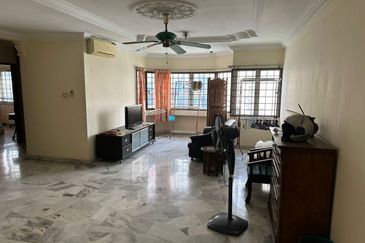
De Tropicana Condominium
Kuchai Lama, Kuala Lumpur
RM 288,000
3 beds |
2 bath |
968 sqft

